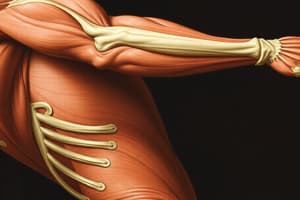Podcast
Questions and Answers
The musculoskeletal system refers to the:
The musculoskeletal system refers to the:
- Bones and voluntary muscles of the body. (correct)
- Connective tissue that supports the skeleton.
- Involuntary muscles of the nervous system.
- Nervous system's control over the muscles.
Skeletal muscle is attached to the bone by tough, ropelike, fibrous structures called:
Skeletal muscle is attached to the bone by tough, ropelike, fibrous structures called:
- Fascia.
- Ligaments.
- Cartilage.
- Tendons. (correct)
A fracture is MOST accurately defined as a(n):
A fracture is MOST accurately defined as a(n):
- Total loss of function in a bone.
- Disruption in the midshaft of a bone.
- Abnormality in the structure of a bone.
- Break in the continuity of the bone. (correct)
With regard to musculoskeletal injuries, the zone of injury is defined as the:
With regard to musculoskeletal injuries, the zone of injury is defined as the:
Which of the following musculoskeletal injuries would MOST likely result in deformity?
Which of the following musculoskeletal injuries would MOST likely result in deformity?
An open fracture is MOST accurately defined as a fracture in which:
An open fracture is MOST accurately defined as a fracture in which:
Crepitus and false motion are:
Crepitus and false motion are:
Which of the following musculoskeletal injuries would pose the greatest threat to a patient's life?
Which of the following musculoskeletal injuries would pose the greatest threat to a patient's life?
A 22-year-old female was ejected from her car. As you approach her, you note obvious closed deformities to both of her femurs. You should:
A 22-year-old female was ejected from her car. As you approach her, you note obvious closed deformities to both of her femurs. You should:
A 54-year-old male accidentally shot himself in the leg. Your assessment reveals a small entrance wound. You should:
A 54-year-old male accidentally shot himself in the leg. Your assessment reveals a small entrance wound. You should:
In general, musculoskeletal injuries should be splinted before moving the patient unless:
In general, musculoskeletal injuries should be splinted before moving the patient unless:
In which of the following situations should the EMT splint an injured limb in the position of deformity?
In which of the following situations should the EMT splint an injured limb in the position of deformity?
During your secondary assessment of a 30-year-old male who fell 25 feet, your partner advises that the patient's blood pressure is 80/50 mm Hg. After completing your assessment, you should:
During your secondary assessment of a 30-year-old male who fell 25 feet, your partner advises that the patient's blood pressure is 80/50 mm Hg. After completing your assessment, you should:
Flashcards are hidden until you start studying
Study Notes
Musculoskeletal System
- Comprises bones and voluntary muscles of the body.
- Functions to provide structure, support, and movement.
Skeletal Muscle
- Attached to bones via tendons, which are tough, fibrous structures.
Fractures
- Defined as a break in the continuity of the bone.
- An open fracture occurs when the overlying skin is no longer intact; bone ends may protrude through the skin.
Zone of Injury
- Refers to the area of soft-tissue damage surrounding a musculoskeletal injury.
- Important for understanding potential complications and treatment.
Deformity from Injuries
- Displaced fractures are most likely to result in visible deformities compared to other types of injuries like strains or sprains.
Crepitus and False Motion
- Indicators of a fracture; crepitus refers to a grating sensation or sound, whereas false motion indicates abnormal movement.
Life-Threatening Injuries
- A pelvic fracture with hypotension poses the greatest threat to a patient's life due to potential internal bleeding and shock.
Patient Assessment
- In case of significant injuries, such as femur fractures, first stabilize the patient's head and conduct a primary assessment.
- For penetrating injuries with bleeding, such as a gunshot wound, control bleeding and cover the wound first.
Splinting Guidelines
- Splint musculoskeletal injuries before moving the patient, unless the patient is clinically unstable.
- If a limb is deformed and moving it causes pain or resistance, splint it in the position of deformity.
Secondary Assessment
- In cases of severe trauma (e.g., falls from height) with signs of shock (low blood pressure, weak pulse), stabilize the pelvis and ensure spinal protection before transport.
Studying That Suits You
Use AI to generate personalized quizzes and flashcards to suit your learning preferences.




